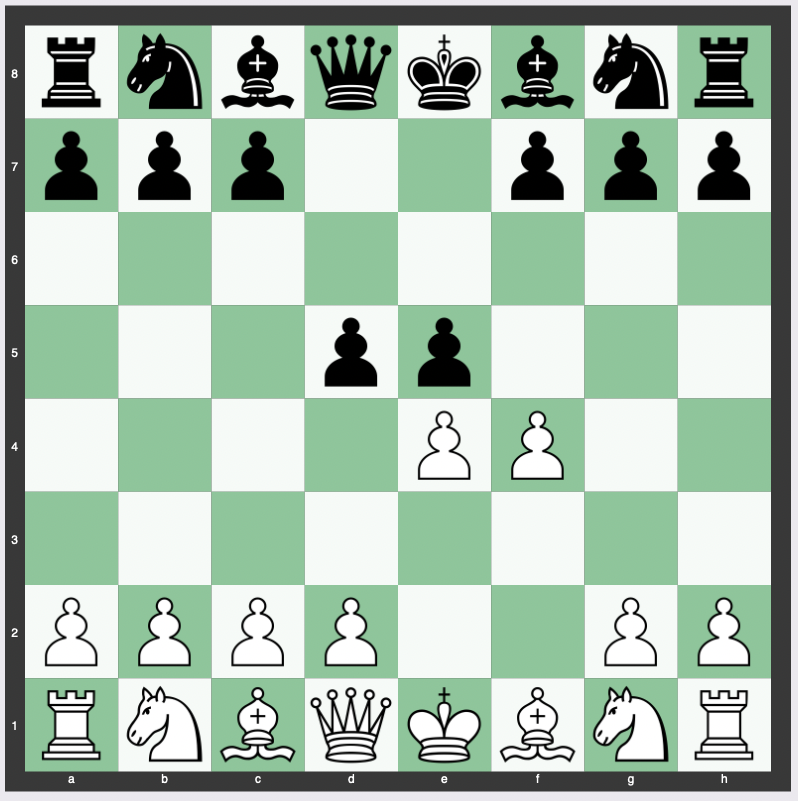The Falkbeer Countergambit is an aggressive and dynamic chess opening within the context of the King’s Gambit theory that is characterized by black’s immediate challenge to white’s control of the center after 1.e4 e5 2.f4 d5.
Instead of accepting the pawn sacrifice typically seen in the King’s Gambit, black strikes at the heart of white’s position, exploiting potential weaknesses on the kingside and creating a complex position rich in strategic and tactical possibilities.
The opening gets its name from the Austrian chess master Ernst Falkbeer, who used it effectively in an 1851 game against Adolf Anderssen.
Historical Background of the Falkbeer Countergambit
Ernst Falkbeer pioneered the countergambit in an attempt to avoid the well-trodden paths of the King’s Gambit Accepted.
The Falkbeer Countergambit seeks to exploit white’s early expansion on the kingside by swiftly opening up the center and counter-attacking.
An important aspect of this opening is the potential for a blunder with 3.fxe5??, after which white either loses material or leaves the king severely exposed to black’s forces.
The Encyclopedia of Chess Openings denotes this opening with the codes C31 and C32.
Move Order of the Falkbeer Countergambit
The move order of the Falkbeer Countergambit is: 1. e4 e5 2. f4 d5

Falkbeer Countergambit – The Old Main Line: 3…e4
The old main line of the Falkbeer Countergambit features 3…e4.
Black’s compensation for the sacrificed pawn is a lead in development and the potential exposure of the white king.
The line can continue as 4.d3 Nf6 5.dxe4 Nxe4 6.Nf3 Bc5, where black targets the f2 square.
Despite having some historic successes, this line has fallen out of favor since World War II due to the difficulties black encounters in maintaining the initiative.
Falkbeer Countergambit: Nimzovich Variation: 3…c6
The Nimzovich Variation of the Falkbeer Countergambit, characterized by the move 3…c6, is a more modern approach that has become the preferred choice for many players, including Grandmaster John Nunn.
This variation was first introduced by Frank Marshall in 1905 and was later employed successfully by Aron Nimzowitsch, giving the variation its name.
Despite its initial successes, the Nimzovich Variation remained relatively obscure for many years.
It provides black with dynamic play and opportunities for counterattacks, with the resulting positions offering black more chances than the Old Main Line 3…e4.
The central tension and pawn structure provide a rich, complex battlefield where both tactical and strategic skills are tested.
Evaluation of the Falkbeer Countergambit
The Falkbeer Countergambit is generally evaluated at around -0.05 to -0.30 for white.
Continuation Lines for the Falkbeer Countergambit
The best replies for white are considered
- 3. exd5
- 3. Nf3
3. exd5 is slightly considered a better move.
3. exd5
3. exd5 exf4 4. Nf3 Nf6 5. c4 c6 6. d4 Bb4+ 7. Nc3 cxd5 8. Be2 dxc4 9. Bxc4 O-O 10. O-O Nc6 11. Bxf4 Bg4 12. a3 Ba5 13. Kh1 Rc8 14. Ba2 Bb6 15. Be5 Bxf3 16. Rxf3 Bxd4
3. exd5 exf4 4. Nf3 Nf6 5. c4 c6 6. d4 Bb4+ 7. Nc3 cxd5 8. Be2 dxc4 9. Bxc4 O-O 10. O-O Nc6 11. Bxf4 Bg4 12. a3 Ba5 13. Nb5 Qd7 14. Qd3
3. exd5 exf4 4. Nf3 Nf6 5. c4 c6 6. d4 Bb4+ 7. Nc3 cxd5 8. Be2 O-O 9. O-O dxc4 10. Bxc4 Bg4 11. Bxf4 Nc6 12. a3 Ba5 13. Kh1 Bxf3 14. Qxf3 Qxd4 15. Ba2 Bxc3 16. Rad1 Qe4 17. Qxc3 Rad8 18. Rde1 Qd3 19. Qxd3 Rxd3 20. h3 Rfd8
3. exd5 exf4 4. Nf3 Nf6 5. c4 c6 6. d4 Bb4+ 7. Nc3 cxd5 8. Be2 O-O 9. O-O dxc4 10. Bxc4 Bg4 11. Bxf4 Nc6 12. a3 Ba5 13. Nb5 Qd7 14. Kh1 Bb6 15. Qd3 Bxf3 16. Rxf3 Nxd4 17. Nxd4 Qxd4 18. Qxd4 Bxd4
3. Nf3
3. Nf3 dxe4 4. Nxe5 Nd7 5. Nc3 Nxe5 6. fxe5 Qe7 7. Qh5 g6 8. Qe2 Bf5 9. Nxe4 O-O-O 10. c3 Qxe5 11. Ng3 Qxe2+ 12. Bxe2 Bd3 13. Bxd3 Rxd3 14. Ne4 f5 15. Nf2 Rd7
3. Nf3 dxe4 4. Nxe5 Nd7 5. Nc3 Nxe5 6. fxe5 Qe7 7. Qh5 g6 8. Qe2 Bf5 9. Nxe4 O-O-O 10. g4 Qh4+ 11. Nf2 Bxc2 12. Qc4 Nf6 13. exf6 Bc5 14. Qxc5 Rhe8+ 15. Be2 Bd3 16. O-O Rxe2 17. Qxa7 Be4 18. Qa8+ Kd7
3. Nf3 dxe4 4. Nxe5 Nh6 5. Nc3 Nd7 6. Qe2 Be7 7. Qxe4 O-O 8. d4 c5 9. d5 Bd6 10. Bd3 f5 11. Qc4 b5 12. Qxb5
3. Nf3 dxe4 4. Nxe5 Nh6 5. Nc3 Nd7 6. Nxe4 Nxe5 7. fxe5 Qh4+ 8. Nf2 Bc5 9. Qe2 O-O 10. c3 Nf5 11. d4 Nxd4 12. cxd4 Qxd4 13. Bd2 Qxb2 14. Rc1 Bb6 15. Nd3 Qxa2 16. Bb4 Qa4 17. Bxf8 Kxf8
Bizarre Opening Trap: Falkbeer Countergambit
Conclusion
The Falkbeer Countergambit is an intriguing and provocative response to the King’s Gambit that transforms the game into a dynamic struggle from the very beginning.
Its rich history and its transformation from the Old Main Line to the Nimzovich Variation illustrate the evolving nature of chess strategy and the ever-changing assessment of opening theory.
Whether viewed as an adventurous choice or a calculated risk, the Falkbeer Countergambit undoubtedly adds excitement and unpredictability to the chess game, inviting both white and black into a complex labyrinth of strategic and tactical possibilities.


